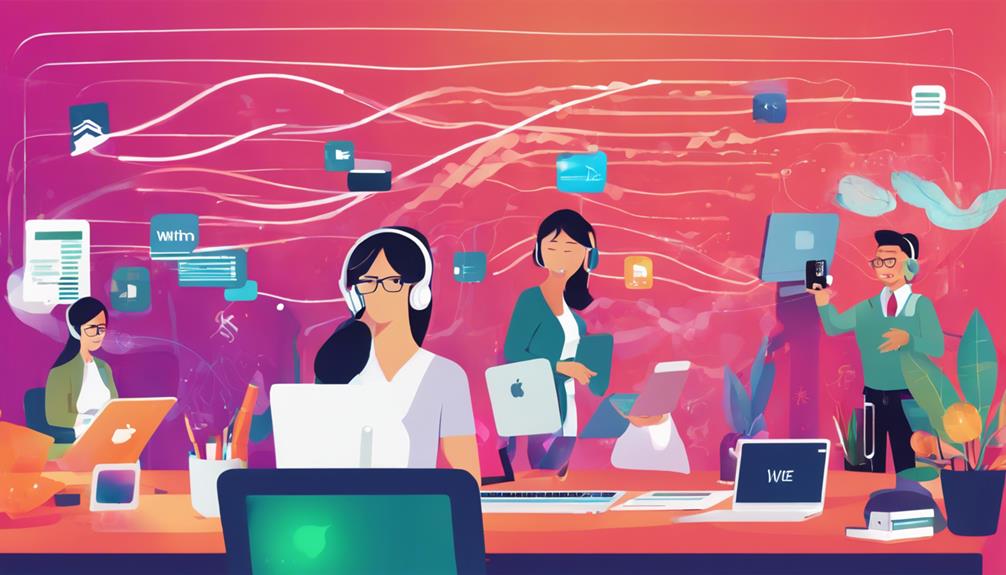Transcribing Vietnamese audio into text boosts your workflow by making information more accessible and promoting better collaboration. You'll eliminate language barriers, helping diverse teams understand and engage effectively. Written records reduce miscommunication and allow for quick scanning of essential points, saving you time in documentation. Plus, clear text enhances focus, making it easier to spot trends and insights. This process not only preserves valuable discussions but also supports language learning. Overall, you'll see improved productivity and engagement in your team. If you're curious about other advantages, there's plenty more to explore on this topic.
Key Takeaways
- Transcription enhances information accessibility, making content reachable for diverse audiences and those with hearing impairments.
- It improves collaboration by providing shared written records, reducing miscommunication among team members.
- Transcribing saves time by allowing quick access to structured data without replaying lengthy audio recordings.
- It fosters better focus on content, enabling deeper engagement and easier identification of trends and insights.
Enhanced Information Accessibility

Transcribing Vietnamese audio makes information more accessible, allowing you to easily reach a wider audience. When you convert spoken content into text, you eliminate language barriers and enhance understanding. Not everyone can follow along with audio, especially those who may have hearing impairments or prefer reading. By providing a written format, you ensure that your message resonates with diverse groups of people.
Additionally, having a transcript enables you to highlight key points and make information easier to reference. Readers can quickly scan the text, pinpointing critical sections without needing to listen to the entire audio. This efficiency improves comprehension and retention, allowing your audience to grasp the essential details without frustration.
Moreover, transcribing audio can boost your content's searchability. Search engines can index text much more effectively than audio, increasing the chances of your content being discovered online. This means more eyes on your work and better engagement with your audience.
Improved Collaboration and Sharing
Converting audio to text facilitates better collaboration and sharing among team members, making it easier for everyone to contribute and stay informed. When you transcribe Vietnamese audio, you create a written record that can be easily shared with colleagues, regardless of their location or preferred learning style. This ensures everyone has access to the same information, reducing the chances of miscommunication.
With text, you can quickly highlight key points, add annotations, or create summaries that help your team focus on what's important. You can also make it easier for non-native speakers to understand the content, as they can read at their own pace.
Moreover, having a text version allows for more effective discussions during team meetings. Instead of relying on memory or vague recollections, you can reference the transcription directly, ensuring everyone is on the same page. This clarity fosters a more inclusive environment where all voices can be heard and valued.
In short, transcribing Vietnamese audio into text enhances collaboration by breaking down barriers and streamlining communication, allowing your team to work more effectively and efficiently together.
Time Efficiency in Documentation

Effective collaboration not only improves communication but also leads to significant time savings in documentation when you transcribe Vietnamese audio. Instead of sifting through lengthy recordings, you can quickly access the text version. This allows you to locate important information, quotes, or insights without wasting time replaying segments.
Transcribing audio speeds up the documentation process, enabling you to create summaries, reports, or meeting notes more efficiently. You won't have to spend hours trying to remember or write down what was said; the text is right in front of you. Plus, having a written record makes it easier to share information with your team, allowing everyone to stay on the same page.
Additionally, you can avoid the tedious task of note-taking during meetings or discussions. With an accurate transcript, you can focus on engaging with participants while ensuring that all essential points are captured. This not only enhances productivity but also fosters a more dynamic environment for collaboration.
In short, transcribing Vietnamese audio into text streamlines your workflow, allowing you to save valuable time and improve overall efficiency in documentation. You'll find that your efforts yield more effective and timely outcomes.
Better Focus on Content
Focusing on content becomes much easier when you have a clear transcript of your Vietnamese audio. With the spoken words converted to text, you're free to engage deeply with the material. Instead of scrambling to catch every word, you can concentrate on the key messages and themes presented. This shift allows you to analyze the content more effectively, enhancing your comprehension and retention.
Having a written document at hand means you can highlight important points, jot down additional notes, or even formulate questions without losing track of what's being said. You'll find it simpler to identify trends and insights, leading to more informed decisions or discussions.
Moreover, the clarity of a transcript helps eliminate any ambiguity that might arise from interpreting spoken language. You won't waste time second-guessing what was said or how it was meant. Instead, you'll have a solid foundation to build upon, allowing your creative and analytical processes to flow unhindered.
In short, transcribing audio into text transforms how you interact with your content, paving the way for a more focused and productive workflow.
Preservation of Valuable Insights

Transcribing Vietnamese audio ensures you capture valuable insights that might otherwise be lost in fleeting moments of conversation. When you convert spoken words into text, you create a permanent record of important points, ideas, and discussions that can be referenced later. This process helps you maintain clarity and accuracy in your work, ensuring that no detail slips through the cracks.
You can easily revisit and analyze conversations, which enhances your decision-making capabilities. By having a written account, you can identify patterns, track progress, and extract actionable insights that might be crucial for your projects or team dynamics. This is particularly beneficial in collaborative environments where ideas can evolve rapidly, and clarity is essential.
Moreover, transcribing creates a shared resource that everyone can access, fostering transparency and collaboration. Your colleagues or stakeholders can review the text, ensuring that everyone is on the same page and reducing misunderstandings. Ultimately, by preserving these insights through transcription, you empower yourself and your team to build on past discussions, driving future success and innovation.
Language Learning Benefits
Capturing spoken Vietnamese through transcription not only preserves insights but also enhances your language learning experience by allowing you to analyze vocabulary, pronunciation, and sentence structure in context. When you read transcribed audio, you get to see how words are used in real conversations, helping you understand nuances that textbooks often miss.
You'll notice common phrases and idiomatic expressions that native speakers use, which can improve your fluency. Plus, transcribing audio fosters active listening skills; you'll pay closer attention to how words sound and connect in sentences. This practice allows you to mimic pronunciation more accurately, bridging the gap between theoretical knowledge and practical application.
Moreover, having a written record lets you revisit challenging sections, making it easier to remember and internalize new vocabulary. You can create flashcards or notes from the transcription, reinforcing learning through repetition. As you engage with the text, you'll also gain a deeper grasp of grammar rules, enhancing your confidence in speaking and writing. Ultimately, transcribing Vietnamese audio is a powerful tool for anyone serious about mastering the language.
Streamlined Data Analysis

How can transcribing Vietnamese audio simplify your data analysis process? When you convert spoken content into text, you gain immediate access to structured data. Instead of sifting through hours of audio, you can quickly locate key points, themes, or trends. This efficiency allows you to focus on what truly matters in your analysis.
Transcribing audio also enhances the accuracy of your data interpretation. With written text, you reduce the chances of miscommunication or misunderstanding that can occur in speech. You'll find it easier to quantify responses, categorize information, and perform sentiment analysis based on the transcribed text.
Moreover, having a written record makes it simpler to share insights with your team. You can collaborate more effectively, as everyone can reference the same material without needing to listen to lengthy recordings. This shared understanding fosters a more cohesive analysis process.
Increased Productivity and Engagement
Increased productivity and engagement often follow when you convert Vietnamese audio into text. By transcribing audio, you create a clear, organized document that's easy to reference. This means you won't waste time sifting through long recordings to find important information. You can quickly scan the text and pinpoint key points, accelerating your decision-making process.
Engagement also rises when your team can access written content. It allows for better collaboration, as everyone can read, annotate, and discuss the material at their convenience. Plus, written formats cater to different learning styles, ensuring that everyone grasps the content effectively. You're likely to see more active participation in discussions when everyone's on the same page.
Additionally, by having a text version of the audio, you can repurpose the content for various platforms. Whether it's for blogs, reports, or presentations, you can easily pull relevant sections, saving you time and effort. This versatility keeps your workflow dynamic and adaptable, which is crucial in today's fast-paced environment. Ultimately, transcribing Vietnamese audio not only boosts productivity but also fosters a more engaged and informed team.
